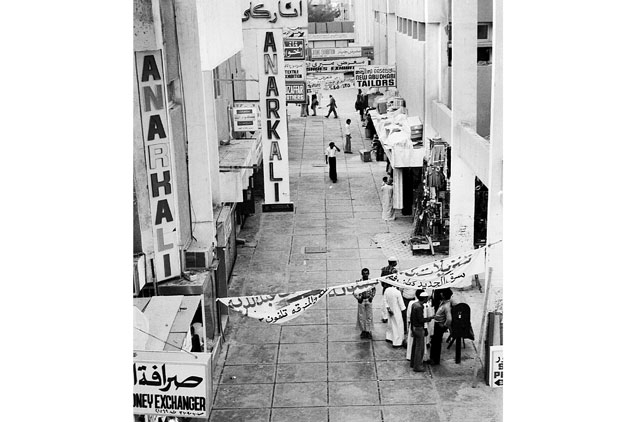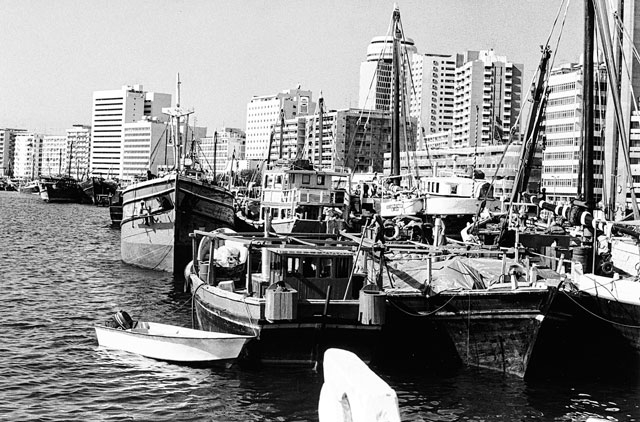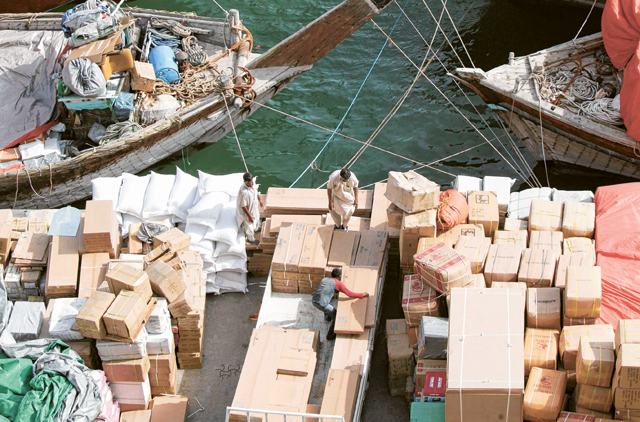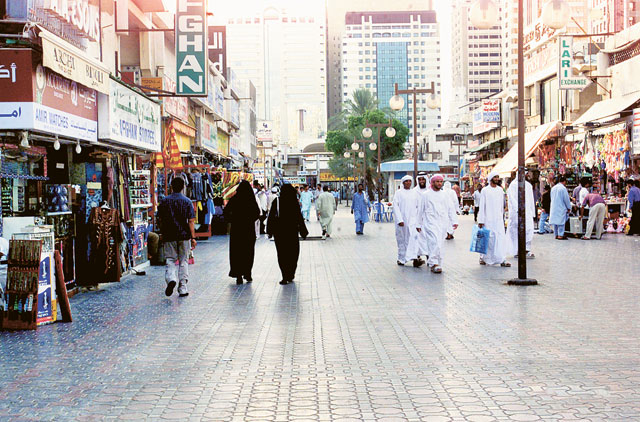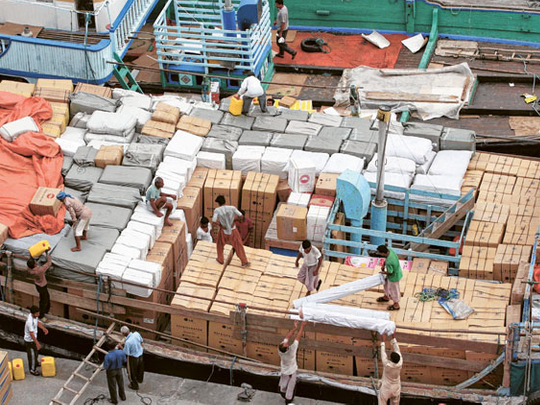
Dubai: While it is commonly accepted that it was oil that catapulted the UAE from a sleepy Arab nation into a regional business hub, in reality it was trade that triggered Dubai's rise from a seaside fishing village to an economic powerhouse.
Long before the first exports of oil in 1962 and the founding of the UAE in 1971, the UAE economy was dominated by pearl diving, fishing, agriculture and livestock.
Dubai became a sufficiently prosperous port, attracting settlers from Iran, India and Balochistan. The country was a natural haven for merchants who left Bandar Lengeh on the Iranian coast after the introduction of high customs duties there in 1902. These people, who were mostly of distant Arab origin, quickly made their homes in the UAE.
A stroll down the wharf of any UAE port, amidst the hustle and bustle of day-to-day business, evokes memories of the city's trading past.
Trucks laden with goods and labourers hurriedly load dhows with cargo ranging from car tyres and batteries, to soft drinks, fabrics, bags of rice to electronics and other consumer goods destined for markets in Africa, as well as the Middle East and beyond.
Leading entry port
"The economy grew as smaller traders followed the more prominent merchants and resettled in the UAE. Despite the significant commercial role of the other emirates, Dubai established itself as the Gulf's leading entry port and the centre of the pearling trade," said Abdullah Al Saleh, director-general of the Ministry of Foreign Trade.
"Pearling and fishing were the primary occupations for the UAE before the federation."
According to Al Saleh, trade other than barter would have hardly existed in the Trucial States, the name of the UAE before the federation, but for the proceeds from the pearling industry.
Pearls and mother-of-pearl constituted almost the only export, while traders imported various goods from neighbouring countries for re-export.
But while Al Saleh is keen to emphasise the importance of non-oil trade to the UAE, he concedes that oil has played a huge role in the country's story.
Latest statistic from the Federal Customs Authority (FCA) said that in terms of value, the UAE's total foreign trade last May hit Dh73 billion compared to Dh61.6 billion in the prior period, an increase of 18 per cent.
May imports, in turn, hit Dh47.8 billion, an increase of 22 per cent. Exports topped Dh8.7 billion, an increase of 21 per cent. Re-exports increased 7 per cent to Dh16.4 billion.
Total foreign trade in May hit 7.1 million tonnes, of which 4.5 million tonnes were imports, 1.9 million tonnes were exports and 716,000 tonnes were re-exports.
Accordingly, the daily averages of consignments and shipments, in exports and imports and re-exports, handled at the ports reached 29,000 tonnes, with a massive 4,000 tonnes per hour being moved.
Export growth
FCA revealed that the first five months of 2011 show a 22 per cent growth in imports, from Dh195 billion in the corresponding period of 2010 to Dh237.4 billion.
Exports grew an astounding 41 per cent in the same period, from Dh31 billion to Dh43.5 billion.
Re-exports experienced a growth rate of 22 per cent, up from Dh73.3 billion to Dh89.4 billion in the same period.
India, China, the United States, Germany, South Korea, Japan, Italy, Switzerland and the United Kingdom topped the exporters' list to the UAE last May, with a total value of Dh28.7 billion, or 60 per cent of total UAE imports.
For non-oil exports, India, Saudi Arabia, Switzerland, Kuwait, Iran, Turkey, France, Singapore, Iraq, Hong Kong spearheaded the list of importers, with Dh5.9 billion, accounting for 68 per cent of the UAE's exports.
Iran, India, Iraq, Belgium, Hong Kong, Saudi Arabia, Afghanistan, Kuwait, Bahrain and Qatar topped the list in terms of re-exports with Dh11.6 billion, 70 per cent of total UAE re-exports.
Gold was the top export last May with Dh4.6 billion, followed by refined oil products at Dh297 million, ethylene polymers at Dh214 million, then ornaments and jewellery and related goods at Dh183 million.
Diamond re-exports
Among re-exports, diamonds topped the list at Dh4.5 billion, automobiles (Dh1.2 billion), ornaments and jewellery and related items (Dh906 million), followed by telephone sets (Dh834 million).
Hamad Bu Amim, director-general of the Dubai Chamber of Commerce and Industry, said it has been Dubai that has been the main player in the Arabian Gulf and the busiest trading port since 1900, with commerce being the main source of revenue for the emirate.
Dubai's merchant class played a key role in restructuring the economy and government decision-making in the pre-oil era.
"Dubai is the region's trading hub, serving as the re-export centre for goods from the West and from Asia to the Middle East and Africa," he said.
"With modern ports and airports and efficient logistics and trading services, Dubai is expected to maintain this key trading position."
He added that with greater clarity in port management among the GCC countries, under the Customs Union, trade with GCC countries is expected to become stronger.
Narrating the evolving story of the UAE, Al Saleh said that by the early 1970s the UAE, as one of the Middle East's top oil producers, was experiencing an unprecedented econ-omic boom.
Diversification
Recognising the risk involved in depending on a single source of income, the leadership decided to encourage alternate industries, develop infrastructure and offer favourable conditions for international companies.
The UAE economy blossomed and a thriving nation emerged from the desert sands in less than half a century.
According to a study by the Ministry of Foreign Trade, major increases in imports have taken place in manufactured goods, machinery and transportation equipment, which together have accounted for 70 per cent of imports.
Another important foreign exchange earner, the Abu Dhabi Investment Authority — which controls the investments of Abu Dhabi — manages an estimated $600 billion in overseas investments.
The report highlighted the significant contribution of free zones to the development of trade in Dubai, not least Jebel Ali, which is home to more than 6,000 companies from more than 120 countries.
Jebel Ali includes a deep-water port and a free trade zone for manufacturing and distribution, in which all goods for re-export enjoy 100 per cent duty exemption. A major power plant with associated water desalination units, an aluminium smelter and a steel fabrication unit are prominent facilities near the complex.
"As far as Dubai is concerned, the opening of free zones was a turning point in the trade sector. Trade in free zones has contributed significantly to the total trade of the emirate," Bu Amim said.
The total trade volume of the free zones and markets last March stood at Dh1.3 billion.
"The UAE is a trading nation, as witnessed by its high ratio of imports plus exports [of goods and services] to GDP, around 142 per cent," Al Saleh, the director-general of the Ministry of Foreign Trade, said.
Capital market player
"The UAE is also an important participant in global capital markets through several investment institutions, including its official Abu Dhabi Investment Authority, DP World, Dubai Holdings, and [the] Abu Dhabi International Petroleum Investment Company," he said.
"Its current account has been in surplus since the federation in 1971, despite large current transfers by expatriate workers and the permanent deficit of the services account, the UAE remains a net services importer."
According to the Ministry of Foreign Trade, this surplus has increased strongly since 2002, as a result of a surge in merchandise exports — in line with rising oil prices — to nearly 12 per cent of GDP in 2004.
The trade balance is traditionally in positive territory, reaching a surplus of $28.1 billion in 2004 and $53 billion in 2007.
Marginal decline
According to the Ministry of Foreign Trade, the export and re-export sector declined 19 per cent in 2009 from the previous year as a result of the global recession.
Another factor contributing to this decline is domestic demand. Domestic demand for goods and services deteriorated due to a combination of both external and internal shocks. A combination of the global and domestic slowdown led to imports falling 16 per cent.
This brought about a significant improvement in the trade deficit. The nation's trade deficit declined 45 per cent in 2009 in comparison with 2008.
Nearly 60 per cent of non-hydrocarbon exports originate in free zones, mainly the Dubai Jebel Ali Free Zone Authority (Jafza), whose main exports are machinery and appliances, computers and other consumer electronics.
The main non-hydrocarbon exports from outside the free zones are clothing, tobacco products, and aluminium. More than 17,000 companies are based in the free zones, with investment topping $21 billion (Dh77.1 billion).
According to official statistics from the Ministry of Economy, net FDI inflows topped $16.86 billion in 2005, while inbound FDI reached $34.08 billion by 2007. In 2008, FDI in the UAE was estimated to have reached $18 billion. The government has launched efforts to improve the collection of statistics on FDI and other indicators of economic performance generally.
— Z.B.


